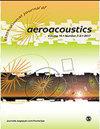Airframe noise predictions using the Ffowcs Williams-Hawkings equation
IF 1.3
4区 工程技术
Q3 ACOUSTICS
引用次数: 2
Abstract
This paper considers potential sources of error when using the Ffowcs Williams-Hawkings equation to make predictions of airframe noise, which entails a relatively low-speed, uniform incoming flow encountering geometry of varying complexity. Numerical simulations are used to investigate several model problems where Ffowcs Williams-Hawkings integration surfaces are placed on solid surfaces as well as in the flow. Comparisons with the pressure obtained directly from the simulations reveal that when solid surfaces are used, the acoustic calculations can produce erroneous results in upstream directions and when scattering bodies block the line of sight from observers to the source. Using solid surface input data implies ignoring all volumetric source effects, which include noise generation as well as flow effects. Nonuniform flow alone, such as is found in a steady boundary layer, was not found to be a significant source of error, so the amplitude and phase changes induced by turbulent eddies in massively separated flow regions is speculated to be the primary cause of the error.使用Ffowcs-Williams-Hawkings方程进行机身噪声预测
本文在使用Ffowcs-Williams-Hawkings方程预测机身噪声时考虑了潜在的误差源,这需要相对低速、均匀的气流遇到不同复杂度的几何形状。数值模拟用于研究几个模型问题,其中Ffowcs-Williams-Hawkings积分表面被放置在固体表面上以及流中。与直接从模拟中获得的压力的比较表明,当使用固体表面时,声学计算可能会在上游方向产生错误的结果,并且当散射体阻挡了从观察者到源的视线时。使用固体表面输入数据意味着忽略所有体积源效应,包括噪声生成和流动效应。在稳定边界层中发现的非均匀流动本身并不是误差的主要来源,因此,在大规模分离的流动区域中由湍流涡流引起的振幅和相位变化被推测是误差的主要原因。
本文章由计算机程序翻译,如有差异,请以英文原文为准。
求助全文
约1分钟内获得全文
求助全文
来源期刊

International Journal of Aeroacoustics
ACOUSTICS-ENGINEERING, AEROSPACE
CiteScore
2.10
自引率
10.00%
发文量
38
审稿时长
>12 weeks
期刊介绍:
International Journal of Aeroacoustics is a peer-reviewed journal publishing developments in all areas of fundamental and applied aeroacoustics. Fundamental topics include advances in understanding aeroacoustics phenomena; applied topics include all aspects of civil and military aircraft, automobile and high speed train aeroacoustics, and the impact of acoustics on structures. As well as original contributions, state of the art reviews and surveys will be published.
Subtopics include, among others, jet mixing noise; screech tones; broadband shock associated noise and methods for suppression; the near-ground acoustic environment of Short Take-Off and Vertical Landing (STOVL) aircraft; weapons bay aeroacoustics, cavity acoustics, closed-loop feedback control of aeroacoustic phenomena; computational aeroacoustics including high fidelity numerical simulations, and analytical acoustics.
 求助内容:
求助内容: 应助结果提醒方式:
应助结果提醒方式:


